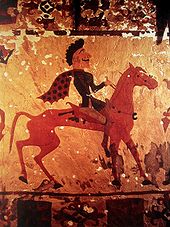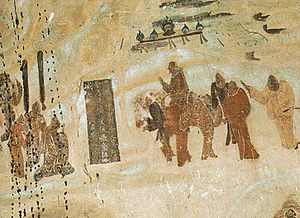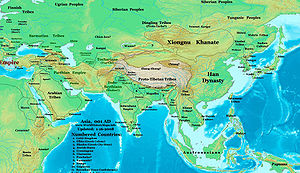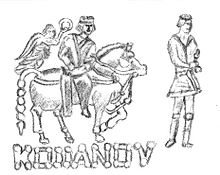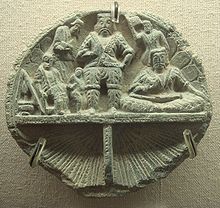- Yuezhi
-
Yuezhi/Rouzhi 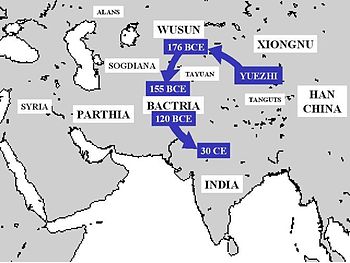
The migrations of the Yuezhi through Central Asia, from around 176 BCE to 30 CE Total population Some 100,000 to 200,000 horse archers, according to the Shiji, Chapter 123.[1] The Hanshu Chapter 96A records: 100,000 households, 400,000 people with 100,000 people able to bear arms.[2] Regions with significant populations Western China (pre-2nd century BCE)[3] Central Asia (2nd century BCE-1st century CE) Northern India (1st century CE-4th century CE) Languages Unknown, although the epigraphy ranges from Greek to Bactrian, and often considered to have spoken a Tocharian language.[4]
Religion Iranian deities (Nana), Buddhism, Zoroastrianism, Hinduism
Related ethnic groups Kushans
The Yuezhi, or Rouzhi (Chinese: 月支; pinyin: yuè zhī or ròu zhī; also Chinese: 月氏; pinyin: yuè shì or ròu shì; Old Chinese: Tokwar),[5] also known as the Da Yuezhi or Da Rouzhi (Chinese: 大月支, dà yuè zhī or dà ròu zhī, "Great Yuezhi"), were an ancient Central Asian people.
They are believed by most scholars to have been an Indo-European people[6] and may have been the same as or closely related to the Tocharians[7] (Τοχάριοι) of Classical sources.[8] They were originally settled in the arid grasslands of the eastern Tarim Basin area, in what is today Xinjiang and western Gansu, in China, before they migrated to Transoxiana, Bactria and then northern South Asia, where they may have had a part in forming the Kushan Empire[citation needed].
Contents
Name
Since the character yuè (月) can stand for the character ròu (肉) in pictograms, it may not mean "moon" here. The character seems to have derived originally from ròu, "meat", as a character component.[9] However, if the form Yuezhi (月氏) is accepted, the name translates literally as "moon clan", from yuè (月), "moon" and shì (氏), "clan" or "race". According to the Kangxi Dictionary, the name came from that of a country beyond China's borders.[10]
There are numerous theories about the derivation of the name Yuezhi, and none has yet found general acceptance.[11][12] According to Zhang Guang-da, the name Yuezhi is a transliteration of their own name for themselves, the Visha ("the tribes"), being called the Vijaya in Tibetan.[13] Some sources identify the Yuezhi with the ancient Tocharians.[14]
Origins
The first known references to the Yuezhi are contained in the Yizhoushu (逸周書), Guanzi 管子(Guanzi Essays: 73: 78: 80: 81) and Tale of King Mu, Son of Heaven. The dates of the most common version of this book are disputed, however, and it may date to as late as the 1st century BCE.[15] The book described the Yuzhi 禺氏, or Niuzhi 牛氏, as a people from the northwest who supplied jade to the Chinese from the nearby mountains of Yuzhi 禺氏 at Gansu.[16] The supply of jade from the Tarim Basin from ancient times is indeed well documented archaeologically: "It is well known that ancient Chinese rulers had a strong attachment to jade. All of the jade items excavated from the tomb of Fuhao (妇好) of the Shang dynasty, more than 750 pieces, were from Khotan in modern Xinjiang. As early as the mid-first millennium BCE the Yuezhi engaged in the jade trade, of which the major consumers were the rulers of agricultural China." (Liu (2001), pp. 267–268). The suffix Di or Zhi (Chinese:氐) was generally used to describe the Di people, called "Western barbarians", in Han Dynasty-era Chinese annals.
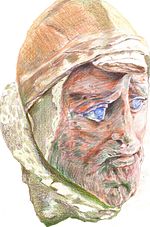 Head of a Yuezhi warrior, from Khalchayan, Surxondaryo Province of southern Uzbekistan, Painted clay.[17]
Head of a Yuezhi warrior, from Khalchayan, Surxondaryo Province of southern Uzbekistan, Painted clay.[17]
According to former USSR scholar Zuev, there was a queen among the large Yuezhi confederation who added to her possessions the lands of the Tochar (Pinyin: Daxia) on the headwaters of the Huanghe c. 3rd century BCE. According to Zuev, the Chinese chronicles began referring to the queen's tribe as the Great Yuezhi (Da Yuezhi) and to the Tochars as the Lesser Yuezhi (Pinyin: Xiao Yuezhi). Together, they were simply called Yuezhi. In the 5th century CE, scholar, translator and monk Kumarajiva, while translating texts into Chinese, used the name Yuezhi to translate Tochar. In the middle of the 2nd century BCE, the Yuezhi conquered Bactria, and the Ancient Greek authors inform us that the conquerors of Bactria were the Asii and Tochari tribes. In the Chinese chronicles Bactria then began to be called the country of Daxia, i.e., Tocharistan, and the language of Bactria/Tocharistan began to be called Tocharian.[18]
The Yuezhi are also documented in detail in Chinese historical accounts, in particular the 2nd-1st century BCE Records of the Great Historian, or Shiji, by Sima Qian. According to these accounts:
- "The Yuezhi originally lived in the area between the Qilian or Heavenly Mountains (Tian Shan) and Dunhuang, but after they were defeated by the Xiongnu they moved far away to the west, beyond Dayuan, where they attacked and conquered the people of Daxia and set up the court of their king on the northern bank of the Gui [= Oxus] River. A small number of their people who were unable to make the journey west sought refuge among the Qiang barbarians in the Southern Mountains, where they are known as the Lesser Yuezhi."[1]
The Qilian and Dunhuang original homeland of the Yuezhi has recently been argued not to refer to the current locations in Gansu, but to the Tian Shan range and the Turpan region, 1,000 km to the west, Dunhuang being identified with a mountain named Dunhong listed in the Shanhaijing.[19]
The Yuezhi may have been a Caucasoid people, as indicated by the portraits of their kings on the coins they struck following their exodus to Transoxiana (2nd-1st century BCE), some old place names in Gansu explainable in Tocharian languages,[20] and especially the coins they struck in India as Kushans (1st-3rd century CE). However, no direct records for the name of Yuezhi rulers are known to exist (only Chinese accounts mention the names.), and there is some doubt about the authenticity of their earliest coins.[21] No Caucasoid skulls were found by archaeologists at the Yuezhi homeland,[22][23] and a site thought to be of Yuezhi and Huns found in the Barkol County showed characteristics similar to a culture in Inner Mongolia.[24][25][26][27]
Ancient Chinese sources do describe the existence of "white people with long hair" (the Bai people of the Shan Hai Jing) beyond their northwestern border. Very well-preserved Tarim mummies with Caucasian features, today displayed at the Ürümqi Museum and dated to the 3rd century BCE, were found at the ancient oasis on the Silk Road, Niya.[28] However, the attribution of reddish or blond hair to these mummies may be in error, since the reddish color can occurs as a result of decomposition over several hundred years (for example, even African mummies also have so-called reddish hair but are clearly not White or European). Notwithstanding, genetic testing and skull examples have shown conclusively that Caucasian genetic material is present in this area. Blond hair among the Tocharian mummies is common, as with certain populations in modern Central Asia and the Middle East.
Evidence of the Indo-European Tocharian languages also has been found in the same geographical area, Although the first known epigraphic evidence dates to the 6th century CE, the degree of differentiation between Tocharian A and Tocharian B and the absence of Tocharian language remains beyond that area suggest that a common Tocharian language existed in the same area of Yuezhi settlement during the second half of the 1st millennium BCE.
According to one theory, the Yuezhi were probably part of the large migration of Indo-European-speaking peoples who were settled in eastern Central Asia at that time. The nomadic people of the Ordos culture, who lived in northern China, east of the Yuezhi, are another example. Also, the Caucasian mummies of Pazyryk, which were probably Scythian in origin, were found around 1,500 kilometers northwest of the Yuezhi and date to around the 3rd century BCE.[citation needed]
According to Han Dynasty accounts, the Yuezhi "were flourishing" during the time of the first great Chinese Qin emperor, but were regularly in conflict with the neighboring tribe of the Xiongnu to the Northeast."
The Yuezhi exodus
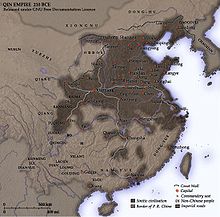 The Yuezhi were settled at the doorstep of Qin China in the 3rd century BCE.
The Yuezhi were settled at the doorstep of Qin China in the 3rd century BCE. A Scythian horseman from the area invaded by the Yuezhi, Pazyryk, c.300 BCE.
A Scythian horseman from the area invaded by the Yuezhi, Pazyryk, c.300 BCE.
The Yuezhi sometimes practiced the exchange of hostages with the Xiongnu, and, at one time, were hosts to Modu Shanyu (冒頓), son of the Xiongnu leader. Modu stole a horse and escaped when the Yuezhi tried to kill him in retaliation for an attack by his father. Modu subsequently became ruler of the Xiongnu after killing his father.
Shortly before 174 BCE,[citation needed] led by one of Modu's tribal chiefs, the Xiongnu invaded Yuezhi territory in the Gansu region and achieved a crushing victory. Modu boasted in a letter (174 BCE) to the Han emperor[citation needed] that due to "the excellence of his fighting men, and the strength of his horses, he has succeeded in wiping out the Yuezhi, slaughtering or forcing to submission every number of the tribe." The son of Modu, Laoshang Chanyu, subsequently killed the king of the Yuezhi and, in accordance with nomadic traditions, "made a drinking cup out of his skull." (Shiji 123. Watson 1961:231).
Following Chinese sources, a large part of the Yuezhi people therefore fell under the domination of the Xiongnu, and these may have been the ancestors of the Tocharian speakers attested in the 6th century CE. A very small group of Yuezhi fled south to the territory of the Proto-Tibetan Qiang and came to be known to the Chinese as the "Small Yuezhi". According to the Hanshu, they only numbered around 150 families.
Finally, a large group of the Yuezhi fled from the Tarim Basin towards the Northwest, first settling in the Ili valley, immediately north of the Tian Shan mountains, where they confronted and defeated the Sai (Sakas or Scythians): "The Yuezhi attacked the king of the Sai who moved a considerable distance to the south and the Yuezhi then occupied his lands" (Han Shu 61 4B). The Sai undertook their own migration, which was to lead them as far as Kashmir, after travelling through a "Suspended Crossing" (probably the Khunjerab Pass between present-day Xinjiang and northern Pakistan). The Sakas ultimately established an Indo-Scythian kingdom in northern India.[citation needed]
After 155 BCE, the Wusun, in alliance with the Xiongnu and out of revenge from an earlier conflict, managed to dislodge the Yuezhi, forcing them to move south. The Yuezhi crossed the neighbouring urban civilization of the Dayuan in Ferghana and settled on the northern bank of the Oxus, in the region of Transoxiana, in modern-day Tajikistan and Uzbekistan, just north of the Hellenistic Greco-Bactrian kingdom. The Greek city of Alexandria on the Oxus was apparently burnt to the ground by the Yuezhi around 145 BCE.[29]
Settlement in Transoxiana
The Yuezhi were visited by a Chinese mission, led by Zhang Qian in 126 BCE,[30] that was seeking an offensive alliance with the Yuezhi to counter the Xiongnu threat to the north. Although the request for an alliance was denied by the son of the slain Yuezhi king, who preferred to maintain peace in Transoxiana rather than to seek revenge, Zhang Qian made a detailed account, reported in the Shiji, that gives considerable insight into the situation in Central Asia at that time.[31]
Zhang Qian, who spent a year with the Yuezhi and in Bactria, relates that "the Great Yuezhi live 2,000 or 3,000 li (832-1,247 kilometers) west of Dayuan (Ferghana), north of the Gui (Oxus) river. They are bordered on the south by Daxia (Bactria), on the west by Anxi (Parthia), and on the north by Kangju (beyond the middle Jaxartes). They are a nation of nomads, moving from place to place with their herds, and their customs are like those of the Xiongnu. They have some 100,000 or 200,000 archer warriors."[1]
Although they remained north of the Oxus for a while, they apparently obtained the submission of the Greco-Bactrian kingdom to the south of the Oxus. The Yuezhi were organized into five major tribes, each led by a yabgu, or tribal chief, and known to the Chinese as Xiūmì (休密) in Western Wakhān and Zibak, Guishuang (貴霜) in Badakhshan and the adjoining territories north of the Oxus, Shuangmi (雙靡) in the region of Shughnan, Xidun (肸頓) in the region of Balkh, and Dūmì (都密) in the region of Termez.[32]
A description of the Greco-Bactrian kingdom was made by Zhang Qian after the conquest by Yuezhi:
- "Daxia (Greco-Bactria) is located over 2,000 li southwest of Dayuan, south of the Gui (Oxus) river. Its people cultivate the land and have cities and houses. Their customs are like those of Ta-Yuan. It has no great ruler but only a number of petty chiefs ruling the various cities. The people are poor in the use of arms and afraid of battle, but they are clever at commerce. After the Great Yuezhi moved west and attacked the lands, the entire country came under their sway. The population of the country is large, numbering some 1,000,000 or more persons. The capital is called the city of Lanshi (Bactra) (modern Balkh) and has a market where all sorts of goods are bought and sold."[33]
In a sweeping analysis of the physical types and cultures of Central Asia that he visited in 126 BCE, Zhang Qian reports that "although the states from Dayuan west to Anxi (Parthia), speak rather different languages, their customs are generally similar and their languages mutually intelligible. The men have deep-set eyes and profuse beards and whiskers. They are skilful at commerce and will haggle over a fraction of a cent. Women are held in great respect, and the men make decisions on the advice of their women."[34]
Invasion of Bactria
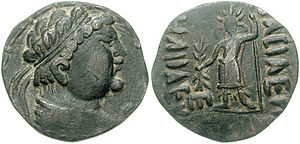 One of the first Yuezhi coins, imitative, in crude style, of the Greco-Bactrian king Heliocles, circa 120 BCE.
One of the first Yuezhi coins, imitative, in crude style, of the Greco-Bactrian king Heliocles, circa 120 BCE.
Obv: Presumed bust of a Yuezhi chief with Greek royal headband.
Rev: Zeus with thunderbolt and sceptre. Misspelled Greek legend BASILEO HELIOLEEU "(of) King Heliocles".In 124 BCE, the Yuezhi were apparently involved in a war against the Parthians, in which the Parthian king Artabanus I of Parthia was wounded and died:
- "During the war against the Tokharians, he (Artabanus) was wounded in the arm and died immediately" (Justin, Epitomes, XLII,2,2: "Bello Tochariis inlato, in bracchio vulneratus statim decedit").
Some time after 124 BCE, possibly disturbed by further incursions of rivals from the north and apparently vanquished by the Parthian king Mithridates II, successor to Artabanus, the Yuezhi moved south to Bactria. Bactria had been conquered by the Greeks under Alexander the Great in 330 BCE and since settled by the Hellenistic civilization of the Seleucids and the Greco-Bactrians for two centuries.
This event is recorded in Classical Greek sources, when Strabo presented them as a Scythian tribe and explained that the Tokharians—together with the Assianis, Passianis and Sakaraulis—took part in the destruction of the Greco-Bactrian kingdom in the second half of the 2nd century BCE:
- "Most of the Scythians, beginning from the Caspian Sea, are called Dahae Scythae, and those situated more towards the east Massagetae and Sacae; the rest have the common appellation of Scythians, but each separate tribe has its peculiar name. All, or the greatest part of them, are nomads. The best known tribes are those who deprived the Greeks of Bactriana, the Asii, Pasiani, Tochari, and Sacarauli, who came from the country on the other side of the Jaxartes, opposite the Sacae and Sogdiani." (Strabo, 11-8-1)
The last Greco-Bactrian king, Heliocles I, retreated and moved his capital to the Kabul Valley. The eastern part of Bactria was occupied by Pashtun people.
As they settled in Bactria from around 125 BCE, the Yuezhi became Hellenized to some degree, as suggested by their adoption of the Greek alphabet and by some remaining coins, minted in the style of the Greco-Bactrian kings, with the text in Greek. The area of Bactria they settled came to be known as Tokharistan, since the Yuezhi were called "Tocharians" by the Greeks.
Commercial relations with China also flourished, as many Chinese missions were sent throughout the 1st century BCE: "The largest of these embassies to foreign states numbered several hundred persons, while even the smaller parties included over 100 members... In the course of one year anywhere from five to six to over ten parties would be sent out." (Shiji, trans. Burton Watson).
The Hou Hanshu also records the visit of Yuezhi envoys to the Chinese capital in 2 BCE, who gave oral teachings on Buddhist sutras to a student, suggesting that some Yuezhi already followed the Buddhist faith during the 1st century BCE (Baldev Kumar (1973)).
A later Chinese annotation in Shiji made by Zhang Shoujie during the early 8th century, quoting Wan Zhen's Strange Things from the Southern Region (a now-lost text of from the Wu kingdom), describes the Kushans as living in the same general area north of India, in cities of Greco-Roman style, and with sophisticated handicraft. The quotes are dubious, as Wan Zhen probably never visited the Yuezhi kingdom through the Silk Road, though he might have gathered his information from the trading ports in the coastal south.[21] The Chinese never adopted the term Guishuang and continued to call them Yuezhi:
- "The Great Yuezhi [Kushans] is located about seven thousand li (about 3000 km) north of India. Their land is at a high altitude; the climate is dry; the region is remote. The king of the state calls himself "son of heaven". There are so many riding horses in that country that the number often reaches several hundred thousand. City layouts and palaces are quite similar to those of Daqin (the Roman empire). The skin of the people there is reddish white. People are skilful at horse archery. Local products, rarities, treasures, clothing, and upholstery are very good, and even India cannot compare with it."[35]
Expansion into the Hindu-Kush
 A posthumus, slightly barbarized, coin of Hermaeus, minted in the Paropamisade between 50 BCE and 25 BCE.
A posthumus, slightly barbarized, coin of Hermaeus, minted in the Paropamisade between 50 BCE and 25 BCE.
Obv: Bust of Hermaeus. Greek legend BASILEOS SOTIROS ERMAIOU "Saviour King Hermaeus".
Rev: Zeus, non-radiating, making a benediction gesture. Kharoshti legend: MAHARAJASA TRATARASA HERAYAMASA "Saviour King Hermaeus".The area of the Hindu-Kush (Paropamisade) was ruled by the western Indo-Greek king until the reign of Hermaeus (reigned c. 90 BCE–70 BCE). After that date, no Indo-Greek kings are known in the area, which was probably[original research?] overtaken by the neighbouring Yuezhi, who had been in relation with the Greeks for a long time. According to Bopearachchi, no trace of Indo-Scythian occupation (nor coins of major Indo-Scythian rulers such as Maues or Azes I) have been found in the Paropamisade and western Gandhara.
As they had done in Bactria with their copying of Greco-Bactrian coinage, the Yuezhi copied the coinage of Hermeaus on a vast scale, up to around 40 CE, when the design blends into the coinage of the Kushan king Kujula Kadphises.
The first presumed, and documented, Yuezhi prince is Sapadbizes (probably[original research?] a yabgu's prince of Yuezhi confederation), who ruled around 20 BCE and minted in Greek and in the same style as the western Indo-Greek kings.
Foundation of the Kushan empire
By the end of the 1st century BCE, one of the five tribes of the Yuezhi, the Guishuang (貴霜, origin of name Kushan adopted in the West), managed to take control of the Yuezhi confederation. According to some theories[citation needed], the Guishuang may have been distinct from the Yuezhi, possibly of Saka origins. From that point, the Yuezhi extended their control over the northwestern area of the Indian subcontinent, founding the Kushan Empire, which was to rule the region for several centuries. The Yuezhi came to be known as Kushan among Western civilizations; however, the Chinese kept calling them Yuezhi throughout their historical records over a period of several centuries.
The Yuezhi/Kushans expanded to the east during the 1st century CE to found the Kushan Empire. The first Kushan emperor, Kujula Kadphises, ostensibly associated himself with Hermaeus on his coins, suggesting that he may[citation needed] have been one of his descendants by alliance, or at least wanted to claim his legacy.
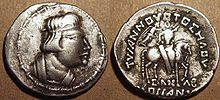 The first self-declared Kushan ruler Heraios (1-30 CE) in Greco-Bactrian style.
The first self-declared Kushan ruler Heraios (1-30 CE) in Greco-Bactrian style.
Obv: Bust of Heraios, with Greek royal headband.
Rev: Horse-mounted King, crowned with a wreath by the Greek goddess of victory Nike. Greek legend: TVPANNOVOTOΣ HΛOV - ΣΛNΛB - KOÞÞANOY "The Tyrant Heraios, Sanav (meaning unknown), of the Kushans".The unification of the Yuezhi tribes and the rise of the Kushan are documented in the Chinese Historical chronicle, the Hou Hanshu:
- "More than a hundred years later, the xihou (Ch:翖侯, "Allied Prince") of Guishuang (Badakhshan and the adjoining territories north of the Oxus), named Qiujiu Que (Ch: 丘就卻, Kujula Kadphises) attacked and exterminated the four other xihou ("Allied Princes"). He set himself up as king of a kingdom called Guishuang (Kushan). He invaded Anxi (Parthia) and took the Gaofu (Ch:高附, Kabul) region. He also defeated the whole of the kingdoms of Puda (Ch: 濮達) and Jibin (Ch: 罽賓, Kapiśa-Gandhāra). Qiujiu Que (Kujula Kadphises) was more than eighty years old when he died.
- "His son, Yan Gaozhen (Ch:閻高珍) (Vima Takto), became king in his place. He returned and defeated Tianzhu (Northwestern India) and installed a General to supervise and lead it. The Yuezhi then became extremely rich. All the kingdoms call [their king] the Guishuang (Kushan) king, but the Han call them by their original name, Da Yuezhi." (Hou Hanshu, trans. John Hill,[36][37]).
The Yuezhi/Kushan integrated Buddhism into a pantheon of many deities and became great promoters of Mahayana Buddhism, and their interactions with Greek civilization helped the Gandharan culture and Greco-Buddhism flourish.
During the 1st and 2nd century, the Kushan Empire expanded militarily to the north and occupied parts of the Tarim Basin, their original grounds, putting them at the center of the lucrative Central Asian commerce with the Roman Empire. When the Han Dynasty desired to advance north, Emperor Wu sent the explorer Zhang Qian to see the kingdoms to the west and to ally with the Yuezhi people, in order to fight the Xiongnu Mongol tribe. The Yuezhi continued to collaborate militarily with the Chinese against nomadic incursion, particularly with the Chinese general Ban Chao against the Sogdians in 84 CE when the latter were trying to support a revolt by the king of Kashgar. Around 85 CE[citation needed], they also assisted the Chinese general in an attack on Turpan, east of the Tarim Basin.
In recognition of their support to the Chinese, the Kushans requested, but were denied, a Han princess, even after they had sent presents to the Chinese court. In retaliation, they marched on Ban Chao in 86 CE with a force of 70,000 but, exhausted by the expedition, were finally defeated by the smaller Chinese force. The Kushans retreated and paid tribute to the Chinese Empire during the reign of the Chinese emperor Han He (89-106).
About 120 CE, Kushan troops installed Chenpan—a prince who had been sent as a hostage to them and had become a favorite of the Kushan Emperor—on the throne of Kashgar, thus expanding their power and influence in the Tarim Basin,[38] and introduced the Brahmi script, the Indian Prakrit language for administration, and Greco-Buddhist art, which developed into Serindian art.
Benefiting from this territorial expansion, the Yuezhi/Kushans were among the first to introduce Buddhism to northern and northeastern Asia, by direct missionary efforts and the translation of Buddhist scriptures into Chinese. Major Yuezhi missionaries and translators included Lokaksema and Dharmaraksa, who went to China and established translation bureaus, thereby being at the center of the Silk Road transmission of Buddhism.[citation needed]
The Chinese kept referring to the Kushans as Da Yuezhi throughout the centuries. In the Sanguozhi (三國志, chap. 3), it is recorded that in 229 CE, "The king of the Da Yuezhi, Bodiao 波調 (Vasudeva I), sent his envoy to present tribute, and His Majesty (Emperor Cao Rui) granted him the title of King of the Da Yuezhi Intimate with the Wei (魏) (Ch: 親魏大月氏王, Qīn Wèi Dà Yuèzhī Wáng)."
Fall of Kushan
The Sassanids extended their dominion into Bactria during the reign of Ardashir I around 230 CE.
Presumed Yuezhi rulers
- Sapadbizes (c. 20 BCE)
- Agesiles (c. 20 BCE)
See also
- Kushan Empire
- Silk Road transmission of Buddhism
- Pre-Islamic period of Afghanistan
- Greco-Bactrian Kingdom
- Indo-Greek Kingdom
- Indo-Scythians
- Indo-Parthian Kingdom
- Indo-Sassanid
- Greco-Buddhism
- Hephthalite
References
Notes
- ^ a b c Watson, Burton. Trans. 1993. Records of the Grand Historian of China: Han Dynasty II. Translated from the Shiji of Sima Qian. Chapter 123: "The Account of Dayuan," Columbia University Press. Revised Edition. ISBN 0-231-08166-9; ISBN 0-231-08167-7 (pbk.), p. 234.
- ^ Hulsewé, A.F.P. and Loewe, M.A.N. China in Central Asia: The Early Stage: 125 B.C.-A.D. 23: An Annotated Translation of Chapters 61 and 96 of the History of the Former Han Dynasty. Leiden. E. J. Birll. 1979. ISBN 90-04-05884-2, pp. 119-120.
- ^ Watson, Burton. Trans. 1993. Records of the Grand Historian of China: Han Dynasty II. Translated from the Shiji of Sima Qian. Chapter 123: "The Account of Dayuan," Columbia University Press. Revised Edition. ISBN 0-231-08166-9; ISBN 0-231-08167-7 (pbk.), p. 234.
- ^ Mallory, J.P. and Victor H. Mair,The Tarim Mummies. Ancient China and the Mystery of the Earliest Peoples from the West. Thames & Hudson, London 2000. ISBN 0-500-05101-1, pp. 280-284,
- ^ Beckwith (2009) See page 5, footnote #16, as well as pages 380-383 in appendix B.
- ^ "They are, by almost unanimous opinion, Indo-Europeans, probably the most oriental of those who occupied the steppes." Roux, p.90
- ^ Mallory (2006), p. 35
- ^ "According to some, they were the Tocharians, "Tokharoi", of Classical Antiquity", Roux, p.90
- ^ Chinese Wikipedia article on 月氏
- ^ Kangxi Dictionary: Yue: ...definition list... also a country outside China. (<<Source: Book of Han, Huo Qubing Biography>> Finally reached the small Yuezhi) (月: 又外國名。《前漢·霍去病傳》遂臻小月氏。)
- ^ Les Saces: Les « Scythes » d'Asie. VIIIe siècle av. J.-C.−IVe siècle apr. J.-C. (2006) Iaroslav Lebedynsky. Editions Errance, Paris, pp. 240-247
- ^ The Tarim Mummies: Ancient China and the Mystery of the Earliest Peoples from the West. J. P. Mallory and Victor H. Mair. Thames & Hudson. London. (2000), pp. 98-99; 280-283. See also: pp. 333-334.
- ^ History of civilizations of Central Asia, volume III: Zhang Guang-da, "The city-states of the Tarim Basin, p. 284
- ^ Hill, John E (2009). Through the Jade Gate to Rome: A Study of the Silk Routes during the Later Han Dynasty, 1st to 2nd Centuries CE. BookSurge, Charleston, South Carolina. ISBN 9781439221341.. pp. 310-312.
- ^ Liu Jianguo (2004). Distinguishing and Correcting the pre-Qin Forged Classics. Xi'an: Shaanxi People's Press. ISBN 7-224-05725-8. p. 115-127.
- ^ "Les Saces", Iaroslav Lebedynsky, ISBN 2-87772-337-2, p. 59
- ^ Encyclopaedia Iranica, PLATE VIII
- ^ Zuev, Ü.A. (2002) Early Türks: Outline of history and ideology, p. 6 (translated from the Russian) ISBN 9985-441-52-9
- ^ Liu Xinru, "Migration and Settlement of the Yuezhi-Kushan: Interaction and Interdependence of Nomadic and Sedentary Societies," Journal of World History 12, no. 2, p. 268 [1]
- ^ 邪说--请大家狂批:华夏文明的白种雅利安人来源
- ^ a b Yu Taishan (2nd Edition 2003). A Comprehensive History of Western Regions. Zhengzhou: Zhongzhou Guji Press. ISBN 7-5348-1266-6.
- ^ 中国北方几个古代民族的体征类型和种族属性
- ^ 大月氏
- ^ 巴里坤:月氏与匈奴的远古王庭
- ^ 《东黑沟——月氏与匈奴人的古家园》
- ^ 月氏?还是匈奴? - 新疆天山网
- ^ 学术通讯
- ^ "The strange creatures of the Shanhai jing: (...) we find recorded north of the territory of the "fish dragons" the land of the Whites (Bai), whose bodies are white and whose long hair falls on their shoulders." Such a description could correspond well to a Caucasoid population beyond the frontiers of ancient China and some scholars have identified these Whites as Yuezhi." The Tarim Mummies: Ancient China and the Mystery of the Earliest Peoples from the West. J. P. Mallory and Victor H. Mair. Thames & Hudson. London. (2000), p. 55.
- ^ Bernard, P. (1994a): "Alexander and his successors in Central Asia." In: History of civilizations of Central Asia, Volume II. The development of sedentary and nomadic civilizations: 700 B.C. to A.D. 250, pp. 88-97. Harmatta, János, ed., 1994. Paris: UNESCO Publishing.
- ^ Silk Road, North China, C.Michael Hogan, The Megalithic Portal, editor A. Burnham
- ^ Watson, Burton. Trans. 1993. Records of the Grand Historian of China: Han Dynasty II. Translated from the Shiji of Sima Qian. Chapter 123: "The Account of Dayuan," Columbia University Press. Revised Edition. ISBN 0-231-08166-9; ISBN 0-231-08167-7 (pbk.), pp. 2231-252.
- ^ Hill (2004), pp. 29, 318-350
- ^ Watson, Burton. Trans. 1993. Records of the Grand Historian of China: Han Dynasty II. Translated from the Shiji of Sima Qian. Chapter 123: "The Account of Dayuan," Columbia University Press. Revised Edition. ISBN 0-231-08166-9; ISBN 0-231-08167-7 (pbk.), p. 235.
- ^ Watson, Burton. Trans. 1993. Records of the Grand Historian of China: Han Dynasty II. Translated from the Shiji of Sima Qian. Chapter 123: "The Account of Dayuan," Columbia University Press. Revised Edition. ISBN 0-231-08166-9; ISBN 0-231-08167-7 (pbk.), p. 245.
- ^ References and quote (Note 36)
- ^ Hill (2009), pp. 28-29.
- ^ 後百餘歲,貴霜翕候丘就卻攻滅四翕候,自立為王,國號貴霜王。侵安息,取高附地。又滅濮達、罽賓,悉有其國。丘就卻年八十餘死,子閻膏珍代為王。復滅天竺,置將一人監領之。月氏自此之後,最為富盛,諸國稱之皆曰貴霜王。漢本其故號,言大月氏云。Hanshu, 96 [2]
- ^ Hill (2009), pp. 14, 43.
Reference sources
- Beckwith, Christopher. (2009). Empires of the Silk Road: A History of Central Eurasia from the Bronze Age to the Present. Princeton and Oxford: Princeton University Press. ISBN 978-0-691-13589-2.
- Dorn'eich, Chris M. (2008). Chinese sources on the History of the Niusi-Wusi-Asi(oi)-Rishi(ka)-Arsi-Arshi-Ruzhi and their Kueishuang-Kushan Dynasty. Shiji 110/Hanshu 94A: The Xiongnu: Synopsis of Chinese original Text and several Western Translations with Extant Annotations. Berlin. To read or download go to: [3]
- Hill, John E. 2003. The Peoples of the West from the Weilüe 魏略 by Yu Huan 魚豢: A Third Century Chinese Account Composed between 239 and 265 CE. Draft annotated English translation. [4]
- Hill, John E. (2009) Through the Jade Gate to Rome: A Study of the Silk Routes during the Later Han Dynasty, 1st to 2nd Centuries CE. John E. Hill. BookSurge, Charleston, South Carolina. ISBN 978-1-4392-2134-1.
- Liu, Xinru: Migration and Settlement of the Yuezhi-Kushan. Interaction and Interdependence of Nomadic and Sedentary Societies in: Journal of World History, 12 (No. 2) 2001, p. 261-292. See [5]
- "Records of the Great Historian, Han Dynasty II", Sima Qian, translated by Burton Watson, Revised edition (1993) Columbia University Press, ISBN 0-231-08167-7
- RICKET,W.A.(1998) Guanzi -Political, Economic, and Philosophic Essays from Early China. Vol.II. Princeton: Princeton University Press.
- The Tarim Mummies: Ancient China and the Mystery of the Earliest Peoples from the West. J. P. Mallory and Victor H. Mair. Thames & Hudson. London. (2000), ISBN 0-500-05101-1
- Roux, Jean-Paul, L'Asie Centrale, Histoire et Civilization (French), Fayard, 1997, ISBN 978-2-213-59894-9
- Yap, Joseph P. Wars With The Xiongnu, A Translation From Zizhi tongjian Chapters 2 & 4, AuthorHouse (2009) ISBN 978-1-4490-0604-4
- Mallory, James (2006). The Oxford Introduction to Proto-Indoeuropean and the Proto-Indoeuropean world. Oxford University Press. ISBN 0199296685
External links
- The Western Regions according to the Hou Hanshu, trans. John Hill
- Linguistic analysis of the connection between Yuezhi and Kushan
- Overview of Xiongnu history and their wars with the Yuezhi
- Craig Benjamin on Yuezhi migrations
- Kasim Abdullaev on Yuezhi migrations in Central Asia
- Lokesh Chandra on Yuezhi translators
- Yuezhi Sapadbizes coins
- Yuezhi Agesiles coins
- On-line Version of the Guanzi.
- Downloadable article: "Evidence that a West-East admixed population lived in the Tarim Basin as early as the early Bronze Age" Li et al. BMC Biology 2010, 8:15. [6]
Categories:- Kushan Empire
- Ancient peoples of China
- Eurasian nomads
- Former countries in Chinese history
- History of India
- Ancient peoples of Pakistan
- History of Kyrgyzstan
- History of Uzbekistan
- History of Tajikistan
- Pre-Islamic history of Afghanistan
Wikimedia Foundation. 2010.

